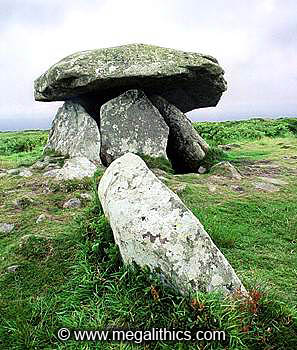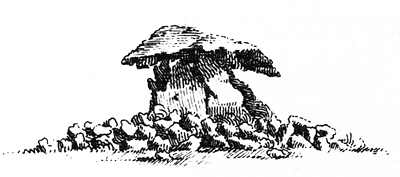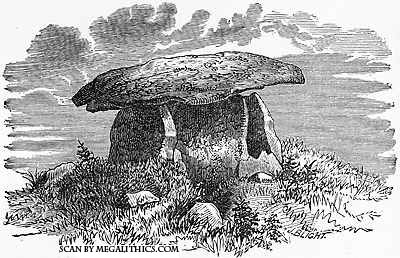
 |
Photo Gallery |
|
VR Panoramas |
||
| SW 40227 33958 (GPS 28min) | |
| Visited June 2000 | No magnetic anomalies |
Arguably the most visually attractive of the Cornish Quoits, from some angles the Chun Quoit bears a strong resemblance to a giant stone mushroom. The name of the Quoit is derived from the Cornish "Chy-an-Woone" which means " the house on the downs". One of the first publications to include the Chun Quoit was by the Cornish antiquarian William Borlase (1), in1769. This book included the drawing of the Quoit below, but the description of the monument was very brief. Borlase does, however, explain why the term "Quoit" is used for Cornish dolmens, "From the oblate and spreading form of the upper Stone (resembling a Discus) this Monument is in Cornwall called by the name of Quoit."

103 years later William's grandson W.C.Borlase (2) published a more detailed account of the Chun or "Chywoone" Quoit and the illustration below. He mentions that "the barrow or cairn, which in some places nearly reaches the top of the side stones on the exterior, is thirty-two feet in diameter, and was hedged round by a ring of upright stones." Both of the Borlase's commented on, and illustrated the survival of the cairn here, and at the Mulfra Quoit. It would appear that even as far back as 200 years ago, it was unusual for any of a dolmen's covering mound to remain.

Although much reduced since the time
of the Borlase's, the remains of the original covering
mound are still readily visible today in the form of small boulders projecting through the
earth in a circle around the Quoit. The mound is estimated to have originally been about
10.5m in diameter, unfortunately it seems that, with the possible exception of a
large stone to the SSE, none of the kerb mentioned by Borlase (2) above has
survived.
The base of the Quoit is comprised of four slabs leaning in on each other in the
usual portal dolmen fashion, these stones support the large capstone which has a
markedly domed profile. All of the stones that make up the Chun Quoit are of the ubiquitous grey granite that nearly
all Cornish megaliths utilise.
Borlase (1) used the extremely domed top of the Chun capstone to dispute a
theory that his Cornish Druids used these stones as sacrificial altars,
"the Table Stone of the Cromleh at Chun, in Morvah, Cornwall, is so very
gibbous, that no Priest could stand on it, either to tend the Fire, or oversee
the consumption of the Victim."
The interior of the Quoit can be accessed via a hole in the lower right side of the SSE base slab. The level of the chamber floor is somewhat lower than the exterior, although the internal height today is nowhere near the 7 feet reported by Borlase (2). The floor is covered with cobble sized stones, these are probably recent additions as Borlase (2) described how the gaps between the side slabs had been covered with smaller slabs "to make it impossible for any of the rubbish of the mound to find its way into the kist." He also described finding a small pit sunk into the centre of the interior, this was not evident during our visit.
The Iron Age hillfort of Chun Castle lies nearby, only 200m away up the hill.
(1) Borlase W. Antiquities Historical and
Monumental of the County of Cornwall, Bowyer and Nichols, London 1769
(2) Borlase W.C., Naenia Cornubiae 1872 Longmans.